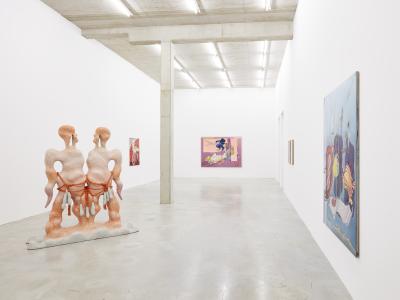Liquid Bodies
Vanessa Conte, Stefanie Heinze, Zsófia Keresztes
06.09.2019 - 27.10.2019
The exhibition Liquid Bodies combines the artistic positions of Vanessa Conte, Stefanie Heinze, and Zsófia Keresztes. They are based on a dynamic, transformative, associative, feminist approach to the negotiation of bodies and objects.
Vanessa Conte's paintings and drawings are curve-intensive. This includes the curves of female bodies as well as the courses of means of transport and streets. Her depictions of objects jiggle jelly-like and oscillate between object and organ. Bicycles are transformed into female body parts such as vulvas, breasts, and asses. They are disproportionately attributed such power and influence that the surrounding city begins to waver. Vanessa Conte's artistic practice is dedicated to the materiality and potential of bodies, which goes hand in hand with an analysis of what "bodies" actually are. In her collection of short stories Cures for Pouting Girls (New York, 2016) and drawings reminiscent of Hentai comics, Conte sketches sadistic and humiliating actions on young, curvy, over-stylized women. Female bodies become the material and venue of a sexual power divide. Despite the drastic depictions of violence, the narration is broken by the strong exaggeration and futility of punishment. They are representations that can oscillate between sexual imagination and rejection, but always ask about the positioning of the author and viewer and open the debate about a male or female gaze.
Tumultuous organizations and surrealistic-looking confusion permeate Stefanie Heinze's painterly oeuvre. Attempts at categorization and wishes for concretization often run nowhere. Heinze's paintings can be located in between, on the threshold of something becoming that happens during the transfer from the preliminary drawing to the painting and from the idea of form to form. She uses the space of translation as an open space for associations and spices them up with playful, caricatural elements. Anthropomorphic forms seem to liquefy, everything becomes stretchable, and every contour distorts like chewing gum in the sun. Heinze does not follow a rigid compositional scheme but intuitively allows what is perceptibly present at the moment of painting. Her body, her subconscious, fruit in the studio. She is going with the flow. Heinze's positioning on topics such as gender issues, sexuality, class relations, psychology, and esotericism do not manifest themselves in a specifically raised index finger, but wash around the little things that are related to it. On the canvas, the space of freedom set by her, failure and rejection are also possible - as gestures of the processual.
The human body, contact, and polite manners are the starting points of Zsófia Keresztes' sculptural works. She places these forms in the context of a globally active, permanently networked world composed of pixels. The surfaces of her life-size sculptures are decorated with small glass mosaic tiles reminiscent both of armor and the composition of screens. Their anthropomorphic beings seem like contact seekers locked or constricted in their shell. With titles such as My dearest enemy, which describes a greatly enlarged uterus with long hair, Keresztes refers to the difficult relationship to her gender. In her works, she analyzes the relationship between closeness and distance and the desire for fusion and demarcation. At the same time, she marks body boundaries as a hurdle and a shelter.
The fluidity of genders has been a social issue for centuries and stands for the permanent renegotiation of relationships, one's sexuality, and one's identity. The exchange of power, forms of punishment, and disciplining of bodies discussed in this exhibition marks the body as a material and venue for socio-cultural contexts. The discourse and politicization of, in this case, the female body and the vulnerability of the human form in general call for a dynamic approach that is far removed from conditioning categories.

Zsófia Keresztes
134 x 126 x 60 cm
Courtesy of the artist & Collection Havrlant
Photo: Paul Schöpfer

Zsófia Keresztes & Stefanie Heinze
74 x 83 x 168 cm
Courtesy of the artist & Gianni Manhattan
oil and acrylic on linen
160 x 180 cm
Courtesy of the artist & Daksal Collection
Photo: Paul Schöpfer

Vanessa Conte, Stefanie Heinze, Zsófia Keresztes
Photo: Paul Schöpfer

Vanessa Conte & Stefanie Heinze
112 × 92 cm Courtesy the artist & Ginerva Gambino
oil and acrylic on linen
170 x 230 cm
Courtesy of the artist & Schroeder Collection
Photo: Paul Schöpfer

Vanessa Conte
182 × 122 cm
Courtesy of the artist & Ginerva Gambino
Photo: Paul Schöpfer

Zsófia Keresztes
245 x 54 x 39 cm
Courtesy of the artist & Gianni Manhattan
Photo: Paul Schöpfer

Vanessa Conte
76 × 76 cm
Courtesy of the artist & Ginerva Gambino
Photo: Paul Schöpfer